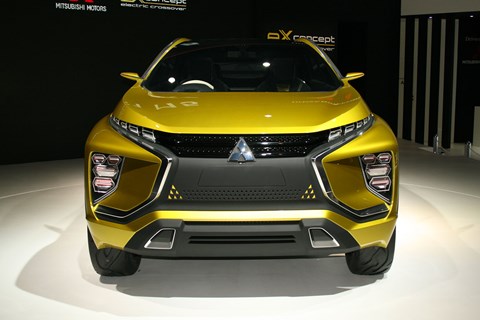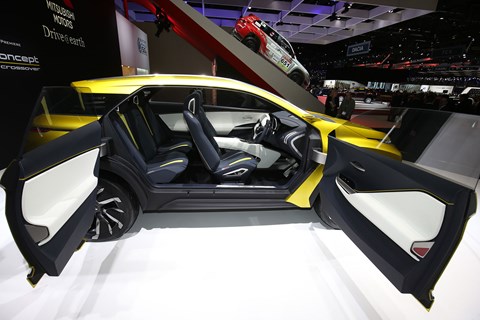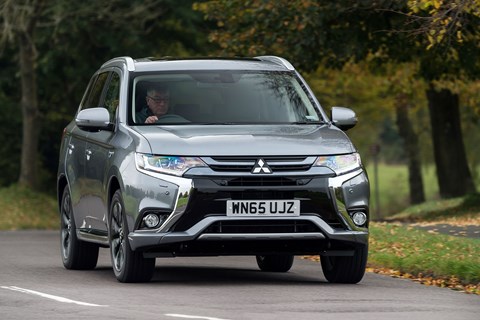► Five new SUV models by 2021
► eX concept previews Juke rival
► More EVs and plug-ins on the way
Mitsubishi will bring five new SUVs to market in Europe by 2021, as it seeks to reposition itself as a brand specialising in 4x4s. That could, however, spell the end for niche family cars, such as the Mirage and other hatchbacks.
The company is concentrating its future product plans almost exclusively on four-wheel-drive SUVs, while continuing its development of pure electric and hybrid powertrains.
‘We will be positioned as a manufacturer of authentic, environmentally responsible 4x4s and SUVs,’ Mitsubishi’s UK managing director Lance Bradley told CAR. ‘We have a clear strategy focused around SUVs, 4wd systems and EV drivetrain technology. Those three things are key competences. We will launch five new models which embrace all three of those things, with a more distinctive design language.’

Talk me through these five new SUV models
In order of size, smallest to biggest:
- A small B-SUV (i.e. Juke/Captur sized), previewed by the yellow eX concept (above) revealed at the 2015 Tokyo motor show and making its European debut at the 2016 Geneva show. Name still to be confirmed
- A mid-sized SUV slightly larger than the ASX, and previewed by 2013’s XR-PHEV II concept. We’ll see the production version, rumoured to be called the Outlander Sport, in 2017
- Replacement for the current Outlander, due in 2018
- The Shogun Sport, a large SUV already on sale in Australian and Asian markets as the Pajero Sport, with a 2.4-litre diesel engine and eight-speed automatic gearbox and built on the same platform as the L200 pickup truck in Thailand. Overseas it’s a five-seater, but UK versions will seat seven. An on-sale date is still being determined, pending homologation logistics
- The replacement full-size Shogun, likely to be the last of the quintet to reach production. Like the current Shogun, it will be built on an entirely different platform from the rest of Mitsubishi’s models
On-sale dates for each of the five models are yet to be confirmed, but the XR concept-based Outlander Sport model is likely to be the first to reach market. All model lines will be offered with a choice of petrol, diesel and hybrid powertrains, depending on market. The Outlander Sport (if indeed that’s what the production car will be called) will use a development of the established plug-in hybrid powertrain in the current Outlander PHEV, while the eX production car will likely be available as a pure EV variant.
Where does this influx of new SUV models leave the Mitsubishi ASX?
That continues until 2019, with a light facelift for 2016 on display at the Geneva show. When the current ASX line comes to an end, its place will effectively be taken by the two smallest models of the new line-up, one being slightly smaller in size and one being slightly larger than the existing ASX crossover. One of them may still use the ASX nameplate; that’s still being decided.
If Mitsubishi’s going to become an SUV brand, where does that leave the Mirage supermini?
There will be a new development of the Mirage next year available as a pure EV, which will give it a more obvious link with other electrified models in Mitsubishi’s new-age line-up.
Beyond that, the model’s future is uncertain. Mitsubishi says Mirage sales in the UK this year are forecast at around 1500 cars, out of a market of 31,000.

Tell me more about the Mitsubishi eX concept
Its name stands for ‘electric crossover’ and it was first shown at the Tokyo motor show in autumn 2015. The 2016 Geneva show marks its European debut.
As the name suggests, it’s powered by a twin-motor, four-wheel-drive pure electric powertrain. The front and rear motors output 70kW each, and take their energy from a 45kWh battery pack for a range of 250 miles.
It’s a far more modern-looking car than the two other concepts next to it on the show stand (‘Geoseek’ variants of the current ASX and L200, with a go-anywhere Bear Grylls vibe, dayglo orange styling details and matching roofboxes), and gives us a few clues as to what kind of design direction we can expect from Mitsubishi under the company’s newly installed design director Tsunehiro Kunimoto.
The eX was designed at Mitsubishi’s recently reopened European design studio near Russelsheim. It looks far smaller in the metal than it appears in photographs, with a wheelbase similar to a Mini, and its 18in wheels appear far bigger in reality courtesy of some neat design illusion, extending the spokes onto the tyre sidewalls. Its front face was inspired by samurai helmets, and the blade-like surfacing along its sides likewise.
There are no B-pillars, and its rear doors are hinged backwards, a design shared with the new L200 club cab pickup truck launching later in 2016.
What’s the current state of play at Mitsubishi in the UK?
The plug-in hybrid Mitsubishi Outlander PHEV (below) has been a big success story, becoming the UK’s biggest selling plug-in vehicle, helped largely by the government plug-in car grant scheme, which has recently switched to a lower-rate, tiered scheme from the beginning of March 2016. Mitsubishi saw a sudden spike in PHEV sales in February 2016, as people looked to bag a bargain before the government contribution was reduced.
Mitsubishi chief Bradley argues that the Outlander PHEV changed the market: ‘It was the right car at the right time, and the price was right – the same as the diesel Outlander – that was key to its success. Also it had boot space, four-wheel-drive.’ Incidentally, he also says that in the week after the Volkswagen emissions crisis became headline news, internet search traffic for the Outlander PHEV went up by 25%.
With Land Rover moving upmarket, Bradley posits there could be an opportunity for Mitsubishi to move into the vacuum it leaves behind, as the Japanese brand repositions itself as a specialist in ‘proper’ SUVs. ‘Land Rover SUVs are excellent products but they are now relatively expensive. Is there a position underneath that, for tough, reliable SUVs that have ecologically friendly drivetrains, and are a bit more affordable to people?’
Mitsubishi’s management believes there is: ‘If Mitsubishi can position itself as a specialist in the three areas of SUVs, 4wd systems and electric drivetrains, there is potential to build quite a strong niche in the market.’

Read more of CAR’s 2016 Geneva motor show coverage here
Click here for CAR’s A-Z guide to the 2016 Geneva motor show